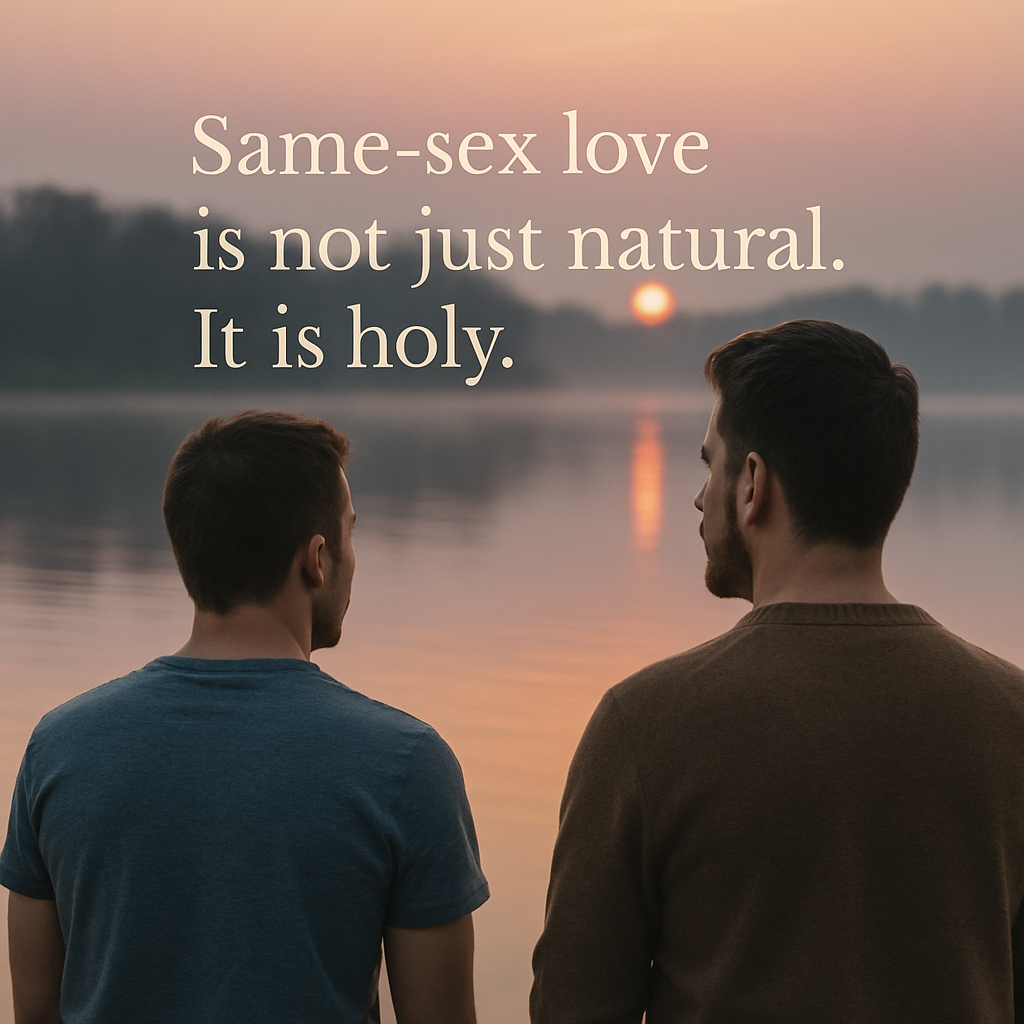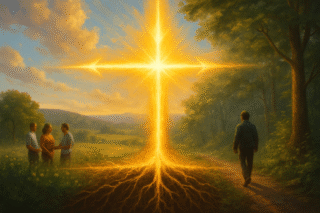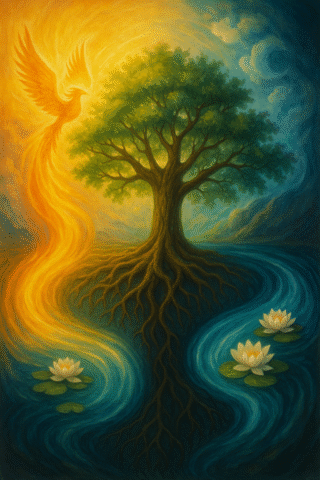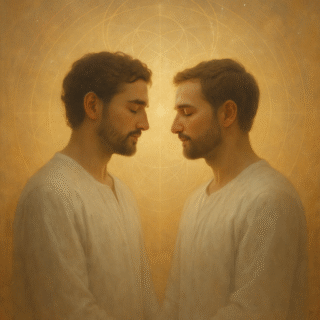GAYNESS AND STRAIGHTNESS: THE MASTER METAPHOR OF TRANSFORMATION
When I began my spiritual pilgrimage some twenty years ago, I looked for gay writers and spiritual teachers who could help me to make sense of some inner knowledge that was hidden from my own consciousness. I looked for wisdom, but nothing I read or heard satisfied my longing. It wasn’t until I started writing The Soulful Blogger that I was finally able to articulate the insight that was missing in the LGBTQ+ community: the insight that same-sex love is a profound divine metaphor, the understanding of which could transform everything.
This insight didn’t arise from dogma, doctrine, or identity politics. It emerged organically—through reflection, meditation, mystical experience, and the alchemical act of writing itself. I came to understand that my same-sex desire was not a problem to be solved or a secret to be hidden. It was a symbol—a living koan pointing beyond itself. And once I saw it, I couldn’t unsee it: gay love reveals a deep spiritual truth about the nature of reality.

Love Flows in Two Directions
In Soulfully Gay, I wrote:
“Gay and straight alike, we transform using the drives of self-transcendence (heterophilia) and self-immanence (homophilia). Love flows in our lives from both creation to Source (other-directed love) and from Source to creation (same-directed love). Homosexuality teaches us about one of the two fundamental directions of Love…” (p. 204)
This statement still lies at the core of my spiritual teaching. The universe, I’ve come to believe, is animated by two great movements of love:
- Self-Transcendence: the reaching out, the expansion into what is other, mysterious, and different. This is the classic mystical journey—love as longing, striving, merging with the Beyond. In terms of erotic archetypes, this corresponds to heterophilia, love of the other.
- Self-Immanence: the return, the recognition of what is already present, the embrace of the same. This is the love that does not climb toward the heavens but descends inward, discovering the divine in the familiar, the intimate, the self-reflective. In eros, this is homophilia—love of the same.
These aren’t merely psychological drives or sexual orientations. They are spiritual polarities. Together, they create the pulse of the cosmos, the breathing of Being itself.
Homosexuality and the Path of Self-Immanence
If heterosexual love is the metaphor for the soul’s journey into transcendence—love of God, love of the Other, love that yearns upward—then same-sex love is the metaphor for the God already within. It is a sacrament of self-immanence, the discovery that the beloved is not “out there,” but right here, mirrored in the same.
This is not narcissism. It’s not the ego falling in love with itself. It’s deeper than identity. Same-directed love—the essence of homophilia—is about recognizing the divine image in one who reflects your own essence. It is the love that affirms that you are not missing anything. You are not estranged from the Source. You are That.
To love one’s own kind—to be drawn to sameness rather than otherness—is to participate in a mystery that has been largely ignored or even condemned by spiritual traditions obsessed with transcendence. But if we listen closely to the body, the breath, the beat of the heart, we might discover that what’s divine isn’t “up there” or “out there,” but right here in the depths of our being.
Fear of the Same: Homophobia and the Rejection of Wholeness
If homophilia is a spiritual metaphor for self-immanence, then what is homophobia?
It is, at its root, a fear of sameness—a rejection of what is close, intimate, reflective. In this way, homophobia is not merely social prejudice. It is ontological fear—a refusal to see the divine mirrored in the self, or in the one who resembles the self. It is the denial of wholeness.
Where same-directed love says “yes” to the God within, homophobia says “no.” It projects the unwanted parts of the self onto others and then punishes them for the reflection. In this sense, homophobia is not just harmful to queer people—it is spiritually impoverishing to everyone.
True healing, then, involves reclaiming homophilia not just as a valid desire, but as a sacred revelation. It is the mirror of love turned inward—not in selfishness, but in wholeness. As we reclaim homophilia, we overcome homophobia and defeat a spiritual dead-end.

A Nondual Understanding of Love
In nondual traditions, we are reminded that the self and the other are not-two. There is no real separation between “I” and “Thou.” All forms, all desires, all beings arise within the single field of awareness that we are.
From this perspective:
- Heterophilia (other-directed love) and homophilia (same-directed love) are not opposites; they are expressions of the same divine energy flowing in different directions.
- Self-transcendence and self-immanence are not in conflict; they are the inhale and exhale of spiritual life.
- Gay love is not merely a human variation—it is a metaphor for cosmic truth.
When I first began writing The Soulful Blogger, I was trying to name this truth without yet having the full language for it. Now, two decades later, having deepened my understanding of nondual wisdom, I see that what I was really pointing to was this: that gay love is not just biologically natural or socially defensible. More than any other single insight I know, the proper understanding of same-sex love as self-immanence erases the distinction between humanity and divinity.
From Shame to Symbol
For too long, same-sex attraction has been treated as something shameful, aberrant, or lesser-than. Even when tolerated, it’s rarely been spiritually honored.
But what if we flip the script entirely?
- What if same-sex love is not just not wrong, but actively holy?
- What if it reveals something about the nature of God, of the soul, of the cosmos itself?
- What if every time two men or two women fall in love, they are enacting a sacred metaphor of divine wholeness?
This is not just a feel-good affirmation. It is a radical theological claim. It suggests that the marginalized experience of same-directed love carries within it a hidden wisdom — a gospel unspoken.
Other gay writers I come across tend to found their theological systems on the basis of an egoic positing of “healthy self-esteem” or Bible quotes or even the presence of homosexuals in ancient cultures. Many gay thinkers don’t even bother with making sense of gayness from within any ontological structure or metaphysics or theological system. But there is value to thinking about same-sex love within the widest possible intellectual context, because only in this way can we connect the dots between our sex lives and our spirituality.
Toward a Mysticism of Same-Sex Love
The time has come to reclaim gay spirituality not merely as inclusion in mainstream religion, but as revelation in its own right. Same-directed love offers us a path of initiation into the mysteries of self-recognition, embodiment, and nonduality.
This is the foundation of my spiritual teaching:
- That gay love is a divine metaphor.
- That homophilia is not just a desire, but a symbol.
- That the same is sacred.
We are not here to mimic heterosexual models or to justify ourselves in someone else’s terms. We are here to awaken—to live into the fullness of our own sacred metaphor.
We are the lovers of the same, and we are here to say: The God you seek is already within you. And sometimes, God comes to you in the form of a person whose face mirrors your own.




